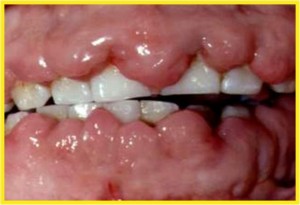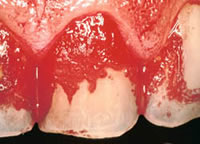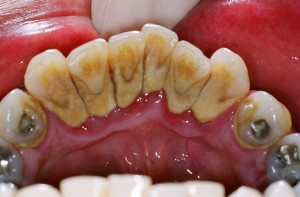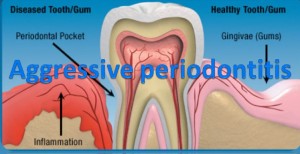With these concepts in mind, let us review the histology of the periodontal pocket, especially in the area of tissue destruction and healing after the periodontal therapy instituted. The periodontal pocket is described as one which occurred with destruction of the supporting periodontal tissues. Progressive pocket deepening leads to destruction of the supporting periodontal tissues and loosening and exfoliation of the teeth. The suprabony pockets are those which the bottom of the pocket is coronal to the underlying alveolar bone. The infrabony pockets are those which the bottom of the pocket is apical to the level of the adjacent alveolar bone and the lateral pocket wall lies between the tooth surface and the alveolar bone. Continue reading
Category Archives: Gum Disease
New attachment and reattachment Part 1
The goal of Periodontal therapy is to halt the disease progression and prevent its recurrence, and restore the lost periodontal structure which occured as the result of the disease destruction. The later goal prompts us to evaluate the concept of “new attachment†or “regenerationâ€, and “reattachment†or “repairâ€. Each concepts will lead to different mode of periodontal therapy, and ultimately different result. New attachment is the ideal, desired goal, which each periodontist today are trying to achieve in every possible way. Continue reading
Types of Scalers
The American Academy of Periodontology published a position in paper summarizing what is known about these instruments and how they compare in their effectiveness (J. Periodontol 2000:71;1792-1801). Recent modifications of tip design for power driven scalers provide improved access into deep pockets and difficult to reach areas such as furcations. Therefore, studies were undertaken to shed light on the potential roles of sonic and ultrasonic scalers in periodontal therapy. Continue reading
Kaposi’s sarcoma Part 2
Mouth
Is involved in about 30%, and is the initial site in 15% of AIDS-related KS. In the mouth, the hard palate is most frequently affected, followed by the gums. Lesions in the mouth may be easily damaged by chewing and bleed or suffer secondary infection, and even interfere with eating or speaking. Continue reading
Kaposi’s sarcoma Part 1
Kaposi’s sarcoma (KS) is a tumor caused by Human herpesvirus 8 (HHV8), also known as Kaposi’s sarcoma-associated herpesvirus (KSHV). It was originally described by Moritz Kaposi (KA-po-she), a Hungarian dermatologist practicing at the University of Vienna in 1872. It became more widely known as one of the AIDS defining illnesses in the 1980s. The viral cause for this cancer was discovered in 1994. Although KS is now well-established to be caused by a virus infection, there is widespread lack of awareness of this even among persons at risk for KSHV/HHV-8 infection. Continue reading
Effect of Systemic Factors on the Periodontium Part 2
Continued from Part 1
Drug reactions
- Epanutin/phenytoin/dilantin/DPH – an anticonvulsant drug given to epileptics, some degree of gums enlargement occurs in a large percentage of epileptics taking phenytoin, especially in those under 40 years of age.
- Cyclosporine – an immunosuppressive drug, it can produce fibrous hyperplasia of the gums. The condition is however less common in patients on cyclosporine, but when it occurs it may be very severe.
- Nifedipine – a calcium channel blocking drug given to treat cardiac angina, arrhythmias and hypertension, it produces fibrous hyperplasia of the gums. Nifedipine hyperplasia is less firm than the other two, and contains a higher proportion of ground substance. Continue reading
Is Dental Plaque the Main Cause of Dental Caries?
Our mouth is constantly bathed in saliva and is exposed to the passage of food, the oral flora and many other stimuli considering the variety of objects that people put in their mouths such as cigarettes, pipes, hair-grips and so on. Nevertheless, our mouth has a remarkable ability to resist and adapt according to these stimulations. Our teeth are also exposed to the same factors and they can be covered wholly or in part by food debris, soft and hard deposits.
Â
Dental Plaque, the main cause of Dental Caries
Dental Plaque is a soft but adherent deposit of bacteria and their products, which forms on all tooth surfaces and other objects in the mouth, for example; fillings or dentures. This Plaque formation is a natural, physiological process and is an example of a biofilm, which means it is not a haphazard collection of bacteria but a complex association of many different bacterial species living together in a single environment. For instance, a newborn baby’s mouth is sterile but within a few hours, microorganisms appear; mainly Streptococcus salivarius. By the time the baby had his/ her first tooth out, a complex flora is established.
Â
Basically, Dental Plaque is scarcely visible in thin layers and it can be revealed only by the use of a Plaque-Disclosing Agent. In thick layers, it can be seen as yellowish or grey deposits which cannot be removed with mouthwashes or by irrigation but can be brushed off. It is usual to find it on areas which are difficult to reach by tooth brushing, for example; in between teeth or in severely crowded teeth. When Dental Plaque calcified or mineralized, it will become Dental Calculus or commonly known as Tartar. It is a ‘stony crust’ that forms on teeth and has long been associated with Gums Disease. Having said that; Dental Plaque is the main cause of dental caries.
Â
Â
     Â
Â
Â
Â
      Â
    Â
Â
Â
Â
Continue reading
Why Are Teeth Sensitive To Cold?
Are you refraining yourself from ice cream, cold drinks, cold air in the mornings when you breathe through your mouth causing a jolt to your teeth and forcing you to stay indoors? Even biting on a candy is causingpressure to your tooth? The answer is simple, you are suffering from sensitive teeth. Wondering how did all this happen? It could be due to various reasons from decay to gum disease. Continue reading
Aggressive periodontitis
Gum disease is not limited to adults. Periodontitis (inflammation of the supporting tissues of the teeth or also known as the periodontium) can also occur in young people. Periodontal disease can generally be divided into different types including chronic, aggressive and necrotizing periodontal disease; with aggressive periodontitis commonly seen in the younger age group. Continue reading
Drug Induced Gingival Enlargement
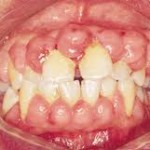 Drug induced gingival hyperplasia is one of the common causes of gingival enlargement. Â
Drug induced gingival hyperplasia is one of the common causes of gingival enlargement. Â
There are three types of drugs highly associated with gingival hyperplasia/enlargement :
1) Antiepileptic drug (Phenytoin)
 2) Immunosuppressive drug (cyclosporine) and 3) calcium-channel blocking drug (nifedipine).
Phenytoin is usually prescribed for the treatment of seizures where as calcium channel blocking drugs are used to treat heart diseases, angina and hypertension.
 The incidence of gingival enlargement is lower in patients who are taking cyclosporine compared to patients who are on phenytoin (Approximately 50 % of patients have gingival overgrowth). However, it can be very severe (covers the entire surface of teeth) when gingival enlargement occurs in patients who are taking cyclosporine. Continue reading
